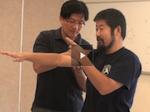Originally written by: John Brown
… I have been working with the bands, focusing on the instructions you have given me.
- The bands really help to recognize whenever there is lack of alignment, or some body part is moving when it should be fixed in place. Also, the bands are extremely valuable to clarify experience of the elbow pulling in to the exact center, while the hand remains fixed in place, yet feels pulling effect away from the elbow. The same effect is felt when the kua sinks down, yet the shoulder feels the separation from the kua.
- This experience of separation of hand from elbow and separation of shoulder from kua, instead of the habit of following one part with other body parts, really enhances the experience of solid center.
- The bands seem quite useful as they magnify the sensations, as any deviation is immediately exposed as pulling outside the centered tension.
- One obvious requirement for this experience is the rock solid foundation of solid stance, without wobbling of center of bottom of kua, and without bending of the knees in any horizontal direction. This has always been difficult to achieve. But the bands really help to “Zero in” on all the angles, again, by exposing wobbling or misalignement.
- I can almost sum up the process in simple terms. So far, I have not been getting stance solid enough, and not enough alignment of shoulders above hips, with head centered pulling up, while tailbone is centered pulling down. Also the importance of the tension centering in the appropriate parts of the feet, and the lower legs, during the rotations.
- All these “details” seem to fall in place by strict attention to the instructions you have given, to pull the elbow in, without following in with the hand, (which is rooted in the fixed front foot on inward part of circle), while the hand always pulls out, in outward part of circle, connected to the back foot.
- It is a most fascinating process find the parts connecting with the whole, when attention is properly focused on a key variable.
Thank you very much,
John



{ 8 comments… read them below or add one }
John,
Thanks for the write up. I cannot possibly write better than this. Here are som eadditional points to consider:
1. the cord/band should be as hard as possible. This prevents the user from having the illusionary “ability” to pull it incorrectly.
2. the footware should be such that they make very solid connection/grip with the floor. This is also very important as any leakage here will make the body wobble.
Very interesting. Thanks for sharing!
Well said John.
I have been working with the rubber bands too and I can relate to everything you have said. Also it is a "fun" change to our daily workout, it gives us a variety to our circles 🙂
Regards,
Jay
This will help me to think of the right things while I pull the bands.
I’m not always sure of what I’m feeling… B) An education in kinaesthetic awareness for sure.
Ted
I just got myself some rubber tubes, can somebody sum up all the things I can train with these cords. I know I can train the circles and yilu as seen in the videos..but is there more I can do with it individually that will benifit my training? Much thanks.
There are many uses of rubber cord, you can use it to provide resistance, or you can use it on your torso as a feedback to check if your torso is stable.
https://www.youtube.com/watch?v=5v2c5TbZ6YA
Studentofmethod.. thats a wonderfull example. Admin2 also much thanks.